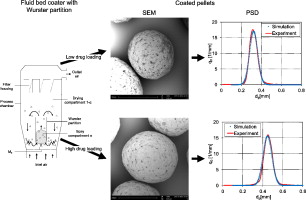Development of high drug loaded pellets by Design of Experiment and population balance model calculation

Medicines of drug coated inert pellets filled into hard capsules or compressed into tablets are already on the market, until now, their number is limited and there are few systematic investigations of possible coating amounts. Pellets of microcrystalline cellulose were coated with a model drug substance and excipients in different concentrations by use of a fluidized bed technique in laboratory scale. In the weight ratio range of coating to core of 0.5:1 to 3:1, the coating process was stable and reproducible for coating liquids with 30% sodium benzoate, PVP 1% and HPMC 2% to improve film stability. In the presence of the anti-sticking agent talcum, it was possible to increase polymer content to PVP 2% and HPMC 3% and therefore to improve film quality. Yields amounted to 85–95%.
The influence of the coating process parameters spray rate, process air temperature and atomization air pressure on the product quality was investigated by a 23 Design of Experiment. The process parameters have no significant influence on the coefficient of variation of the mean particle diameter. A high spray rate in combination with high atomization air pressure leads to increased yield values up to 98%. The coating process is stable, robust and reproducible within the chosen levels of the process parameters. Increasing coating layer leads to products with improved properties, particularly high sphericity, increased surface smoothness and a constant coefficient of variation of mean particle diameter referring to homogeneous film formation. The weight ratio of coating to core of 3:1 represents an optimum compromise of high drug loading, satisfactory yield and high drug recovery rate. The mean particle size increase in the fluidized bed coating process is predicted by a population balance model simulation in what was found to be in agreement with the experimental trials.

